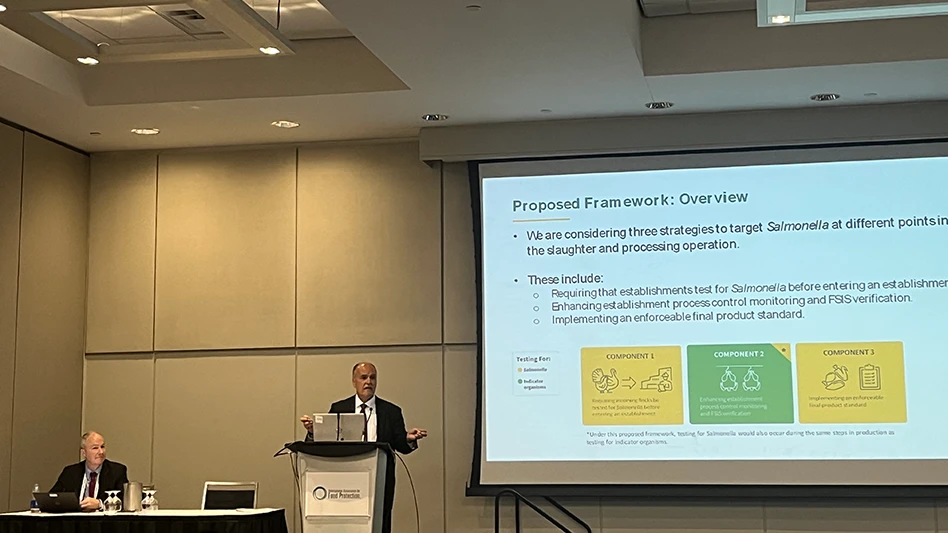
TORONTO — Day two of the International Association for Food Protection’s IAFP 2023 included updates on food safety regulation from two Canadian agencies and food safety priorities from the United States Department of Agriculture (USDA) and the United States Food and Drug Administration (FDA), plus a full day of sessions.
USDA PRIORITIES. Addressing a standing room only audience at the late breaking session “Current USDA and U.S. FDA Food Safety Priorities,” USDA Under Secretary for Food Safety Jose Emilio Esteban laid out his vision and priorities for the future.
 It was standing room only at the late breaking session "Current USDA and U.S. FDA Food Safety Priorities."
It was standing room only at the late breaking session "Current USDA and U.S. FDA Food Safety Priorities."USDA is considering three strategies to target Salmonella at different points in the slaughtering and processing operation, Esteban said. These include requiring incoming flocks be tested for Salmonella before entering an establishment, enhancing establishment process control monitoring and FSIS verification and implementing an enforceable final product standard.
USDA’s Food Safety and Inspection Service (FSIS) is still accepting comments after proposing to declare that not-ready-to-eat breaded stuffed chicken products that contain Salmonella at levels of one colony forming unit per gram or higher are adulterated, Esteban said.
“We have a comment period for this ending July 27. We’ve received a request to extend that by an additional 90 days,” he said. “We’re assessing how much longer time we can give … We expect that within the next few months, we will issue a final rule on this.”
On June 21, FSIS issued three grants of inspection to establishments producing FSIS-regulated products derived from animal cell-culture technology, allowing three companies to begin producing and selling lab-grown chicken.
“We are really looking forward to see how this works,” said Esteban.
Another priority is USDA’s proposed rule for voluntary “Product of the USA” labels, he said, which allows the label claim to be used on meat, poultry and egg products only when they are derived from animals born, raised, slaughtered and processed in the U.S. The current rule only requires food to be processed in the U.S., Esteban said.
“I’m very passionate about transparency,” he said. “If somebody’s going to go into a store and buy something that says ‘Product of the U.S.,’ they should clearly understand what we mean by Product of the U.S.”
FDA UPDATES. Donald Prater, acting director of the Center for Food Safety and Applied Nutrition, FDA, gave an update on FDA’s priorities and its progress in creating a new Human Foods Program.

Prater said the organization is undergoing the largest reorganization he’s seen in his career.
“I think what we’re doing at FDA now really is a historic opportunity,” he said. “We seldom have the opportunity to step back and to see how these things all work together. And that’s what we’re doing right now at FDA. … It’s not going to be just another reorg moving boxes around. You can expect that we’ll be operating differently.”
Recruitment for the new deputy commissioner for human foods is underway, said Prater.
“I think they’re actually getting pretty close,” he said.
Another FDA priority is the New Era of Smarter Food Safety, said Prater, and its aim to enhance traceability, improve predictive analytics, respond more rapidly to outbreaks, address new business models, reduce contamination of food and foster the development of stronger food safety cultures.
Prater said FDA is also focusing on conducting root cause analysis.
“If we’re going to actually prevent foodborne illness, we have to figure out what caused that contamination in the first place,” he said. “… I think you’ll be hearing a lot more about root cause analysis in the future.”
FDA’s GenomeTrakr, a laboratory network that uses whole genome sequencing for pathogen identification, is another priority, said Prater.
“We estimate that for every 1,000 isolate sequences added to the database for a given pathogen, there’s a reduction of approximately six illnesses per year associated with that pathogen,” he said.
Prater also cited the traceability rule, infant formula, the Closer to Zero initiative and chemicals in food as priorities for the administration.
REGULATORY ROUNDUP. Pamela Aung Thin, associate assistant deputy minister, Health Canada, and Diane Allan, vice president of science, Canadian Food Inspection Agency, provided updates within their respective agencies during the Canadian Regulatory Update on Food Safety.

Health Canada conducts food research and surveillance to help develop and advance food safety and nutrition policy guidelines and standards.
“Research and surveillance allow us to take nimble regulatory actions and make decisions to protect the health of Canadians,” said Aung Thin. “We work to prevent and manage foodborne outbreaks, ensure chemicals are not present in food at levels that pose an unacceptable risk to Canadians, and we protect Canadians from health risks due to insufficient or excess intake of nutrients.”
Some of Health Canada’s goals for the future, Aung Thin said, include investing in food safety research and surveillance; conducting focused engagement with partners and industry; leveraging collaborations among governments, industry and academia; and reducing regulatory barriers to remain agile and responsive.
The Canadian Food Inspection Agency is “the inspector of all food policy and regulatory changes within Canada in the food space,” said Allan.
Annually, CFSI receives about 2,150 consumer complaints and reports regarding food safety issues and is responsible for investigating these claims and removing unsafe products from the marketplace, Allan said.
CFSI partners with with Health Canada often, including recently on a policy on Listeria in ready-to-eat foods.
Current CFSI projects include a partnership with Innovative Solutions Canada on two food safety projects: developing innovative devices to detect marine biotoxins in shellfish and developing a portable test to detect environmental domoic acid in marine waters.
DIVERSITY, EQUITY, INCLUSION. During the session “Diversity, Equity, Inclusion and Belonging Considerations Across the Food Supply Chain,” speakers Suzanne Hathaway, senior vice president, general counsel, communications and corporate secretary, Maple Leaf Foods, Mississauga, Ontario; Vijay Krishna, global vice president, quality and regulatory affairs, Glanbia Performance Nutrition, Downers Grove, Ill.; and Tamika Sims, senior director, food technology communications, International Food Information Council shared how their companies have strengthened their Diversity, Equity, Inclusion and Belonging (DEIB) programs.
Sims said that internal DEIB work at her company included hiring a DEIB consultant who introduced new ideas to the team and helped foster conversation.

“She also created space for us, space where you can express yourself, a safe space where you know that you’re being heard and that whatever you share can be fuel for driving the DEIB journey forward,” she said.
Angela Shaw, outgoing chair of IAFP’s DEI Council, said IAFP is looking at how to adjust policies and procedures to make all feel included and welcome and to make the annual meeting itself more accessible. The organization is seeking membership feedback to turn into an action-oriented DEI plan, she said.
“We are trying to embrace the identities of all of our membership,” Shaw said.
Latest from Quality Assurance & Food Safety
- Calbee America Launches California R&D Innovation Center
- PepsiCo Completes Acquisition of Siete Foods
- Non-GMO Project Launches Non-Ultraprocessed Foods Verification
- FDA to Hold Webinar on Updated ‘Healthy’ Claim
- High-Tech Partnership Creates Natural Blue Color for Greener Tomorrow
- Kraft Heinz Hosts Innovation Challenge for Sustainable Packaging
- FDA Requests Information on Poppy Seeds
- Danone North America Opens Applications for Annual Gut Microbiome, Yogurt and Probiotics Fellowship Grant





